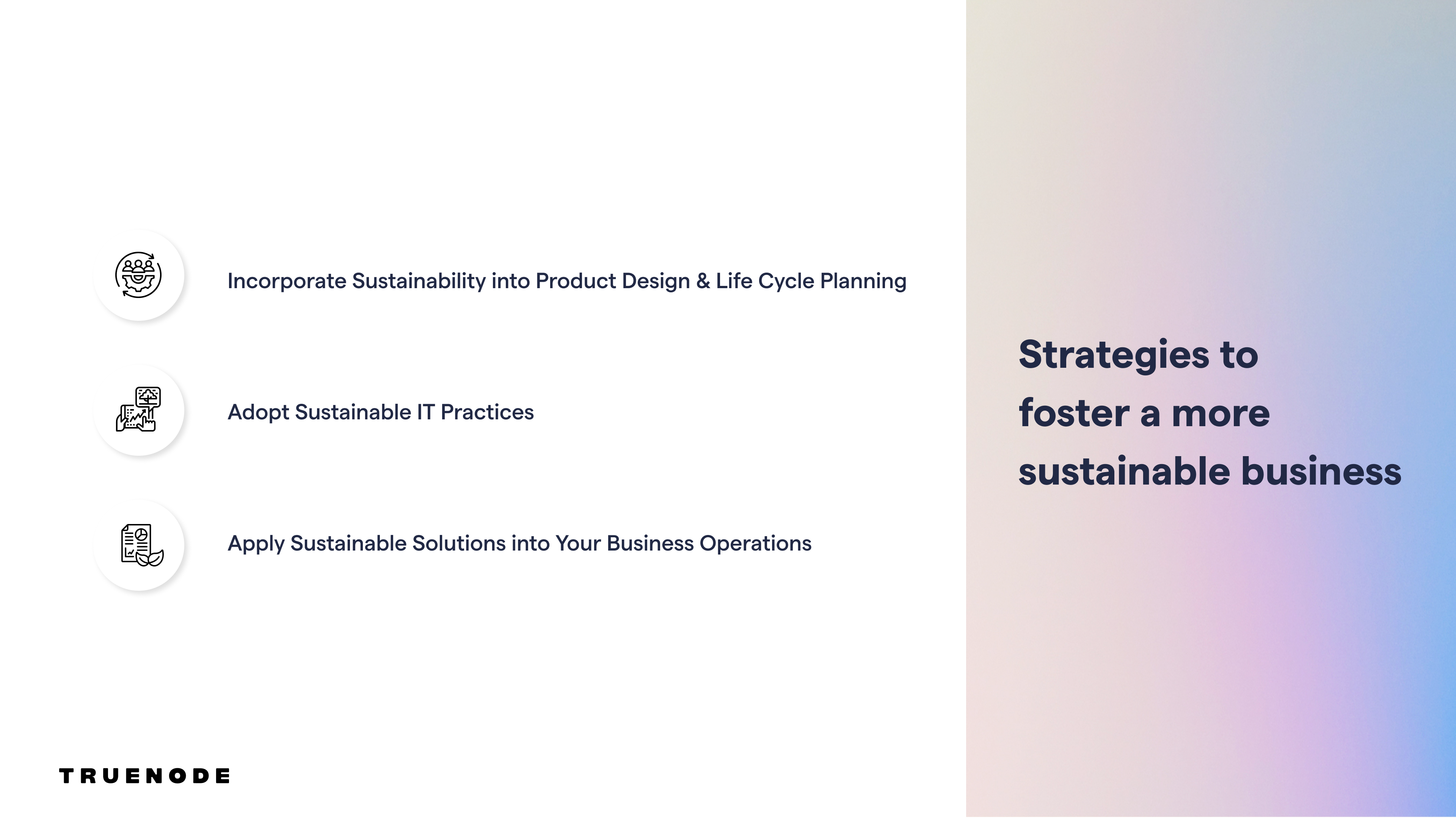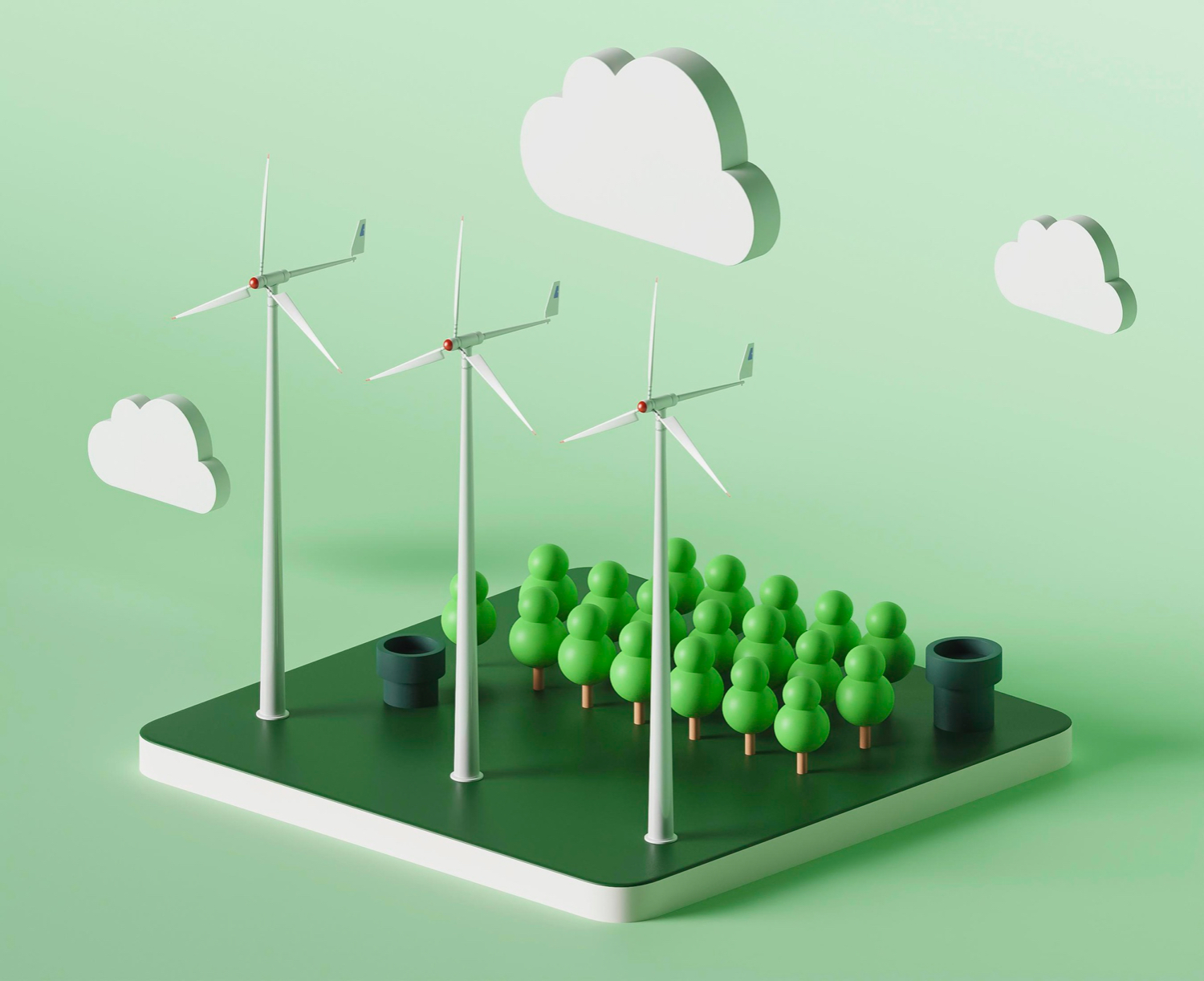Article

Strategies and Best Practices to Foster a More Sustainable Business
As the sound of alarm bells on climate change echo through the air, it is time to think about making our sustainability initiatives bigger and better.
“What humans do over the next 50 years will determine the fate of all life on the planet” – says David Attenborough. He further emphasizes the role of the business’s sector, asserting that “many individuals are doing what they can, but real success can only come if there is a change in our societies, economics, and politics.”
No longer is there any doubt that sustainability should be an integral part of any business strategy. I am certain that your business is already making great strides in this area, too. What we want to emphasise with this article is that companies that have embraced digital innovation as part of their core values should take the lead in making a change to promote sustainability.
So, as a strategic and technological partner of many innovative corporate enterprises and Mittelstand companies, we are committed to helping our clients achieve this goal.
This article offers helpful strategies to take your sustainability initiatives to the next level and ensure that you are doing your part to protect the environment.
Identify the Most Important Sustainability Goals for Your Organization
Before starting, always ensure to carefully select your objectives and stay focused on achieving them.
In our recent interview with Hansgrohe’s Head of Innovation and Sustainability, Steffen Erath, he said: “The purpose of a company is an important question to consider when choosing what problems to solve. Just ask the question: What would happen to society if your company is not there anymore? This way, you can come up with real topics. To gain further insight, the Sustainable Development Goals (SDGs) developed by the United Nations can be used as a guide. These 17 areas provide a framework for understanding the impact of a company on the environment. For example, SDG 6 focuses on water access and availability in both the global north and south. This broad topic can then be broken down into more specific areas such as water in the home, water in bathroom, etc. So, now we have a starting point and while we need to think outside the box, we need to stay in our purpose box.
So, once you are clear what the purpose of your company is, this will serve as a guide to choose and prioritise the problems you should solve.”
Leadership teams should become well-versed in the Sustainable Development Goals (SDGs) and recognize which ones are most relevant to their business’s purpose. By transforming these SDG objectives into an aligned project portfolio and budget, and then measuring the outcomes to demonstrate the achievement, organizations can reach their sustainability objectives.
Below, we have put together a compilation of strategies to help make your business more sustainable.

Strategies to foster a more sustainable business
1. Incorporate Sustainability into Product Design and Life Cycle Planning
Planning and designing with sustainability in mind helps reduce environmental impacts and energy consumption during the product’s life cycle, while also helps build products that are both people- and planet-friendly. Without taking this into account, the resulting products could be unsustainable, detrimental to the environment, and require costly redesigns at a later stage.
In order to design digital products responsibly, it is necessary to take the following practices into consideration.
Ensure circular economy strategies are applied throughout the product life cycle. Circular economy strategies can be applied at each stage of the product life cycle, from design (reducing raw material inputs and waste outputs, designing for durability and reusability) to production (closed-loop processes, renewable energy, minimizing waste) to use (rental, sharing, leasing) to end-of-life (reuse, remanufacturing, recycling). Companies must take steps to ensure efficient and sustainable products throughout the life cycle.
Apply sustainable Web Design practices. Sustainable web design is the practice of creating digital products and services that are both people- and planet-friendly. It calls for designing web pages in a way that reduces their environmental impact, such as using materials that are energy-efficient, increasing recyclability, and reducing waste. It also involves optimizing the page for speed and performance, and making it accessible for people with disabilities. This respects the principles of the Sustainable Web Manifesto, which focuses on a clean, efficient, open, honest, regenerative, and resilient internet.
Tim Frick’s Designing for Sustainability: A Guide to Building Greener Digital Products and Services from O’Reilly Media provides an excellent guide to applying sustainable design practices to the creation and optimization of digital products and services. It teaches us how to create a more sustainable web while still providing a great user experience.
Utilize green design innovation. Green innovation refers to all forms of innovation that reduce environmental damage and use resources effectively. Electric cars, solar energy, green building materials, smart thermostats, energy-efficient lighting, carbon offsetting and eco-friendly manufacturing are all examples of green innovations. These are helping individuals, businesses and governments reduce their environmental impact and create a more sustainable future.
2. Adopt Sustainable IT Practices
The sustainable IT enterprise is accountable for the sustainability of their IT equipment, applications, software, data, and information in data centers and the cloud, as well as cyber security.
Optimize energy consumption of IT equipment. Reducing energy consumption can be achieved through the use of energy-efficient hardware, software, and services. The use of energy-efficient hardware, such as servers and desktop computers, can reduce electricity consumption and help organizations save money.
Reuse and recycle hardware. Organizations can reduce their environmental impact by reusing and recycling hardware, such as servers, PCs, and other IT equipment, and by donating or re-purposing old IT equipment.
Adopt green IT policies. Organizations can adopt green IT policies to reduce their environmental impact, such as reducing travel and paper use, as well as encouraging the use of environmentally friendly IT equipment.
Implement green data centers. Organizations can reduce their environmental impact by implementing green data centers, which use renewable energy sources such as solar and wind, as well as more efficient cooling systems.
Utilize cloud computing and virtualization. Organizations can reduce their environmental impact by utilizing cloud computing, which reduces the need for physical servers and other IT equipment. Furthermore, virtualization also allows businesses to create multiple virtual machines that can be used for different tasks, making them more efficient and flexible. This can lead to significant cost savings, as well as increased responsiveness to customers.
You can find a comprehensive overview of all sustainable IT practices in the book, “Sustainable IT Playbook for Technology Leaders: Design and Implement Sustainable IT Practices and Unlock Sustainable Business Opportunities.”
3. Apply Sustainable Solutions into Your Business Operations
Implementing sustainable solutions into your business operations is not only the right thing to do for the planet, but it can also help to improve your bottom line.
In today’s world, customers are looking for businesses that are making an effort to reduce their environmental impact. Incorporating sustainable solutions into your business operations is one way to demonstrate that you are committed to protecting the environment.
Here are some ways you can apply sustainable solutions into your business operations:
Better delivery, fewer emissions. Finding more efficient and environmentally conscious delivery methods is essential for businesses. Look for delivery services that are focused on reducing emissions and taking other steps to be more sustainable.
Reuse, recycle & cut down on packaging waste. Retail stores create a lot of waste with packaging. Find ways to reduce the amount of packaging your business uses and make sure that any packaging you do use is recyclable.
Eco friendly workplaces. Your employees are a major factor in your business’s sustainability. Make sure that they have access to eco-friendly workspaces, that their occupational health and safety is taken into account, and that they are treated fairly. For example, Aldi is improving conditions for workers in its global supply chain.
Carbon negative email marketing. If you use email marketing to reach out to customers, make sure that you’re using a platform that is focused on reducing its carbon emissions. Platforms such as HubSpot, ActiveCampaign or Intercom are all focused on reducing their carbon footprint.
Hybrid model working. Working from home can help to reduce carbon emissions, as it takes millions of cars off the roads. During the recent pandemic lockdowns, the UK’s carbon emissions fell by almost 40%.
Remote events or local based events. Having remote events or local based events can help to reduce carbon emissions from travel. This is a great way to reduce your business’s environmental impact while still providing an engaging event experience.
Incentivize employees to encourage sustainable commuting. Offering incentives for employees to use public transportation, carpool, or bike to work is a great way to reduce the environmental impact of commuting. By providing benefits such as free transit passes, discounted rates on carpooling services, or providing bicycles for commuting, businesses can encourage their employees to switch to more sustainable means of transportation.

Communicate Your Sustainability Efforts Internally & Externally
It is vital for organisations to communicate their sustainability efforts both internally and externally. Internally, communication is key for engaging your employees, who are the heart of your organisation and are likely to be your biggest advocates. To ensure that your team is motivated and engaged in your sustainability initiatives, they must be kept up to date with the progress and successes, as well as the challenges you face.
Externally, communicating your sustainability efforts is just as important. This can help to strengthen your brand, build trust with customers and stakeholders, and even attract new talent. It can also help to raise awareness of your organisation and its activities, and provide a platform for demonstrating your values.
If you’re looking to make your business more sustainable, start by researching the available options and determining which strategies are the most relevant and feasible for you to implement. By taking action now, you’ll be helping create a more sustainable future for everyone.
This article has focused on environmental sustainability, however, it is important to remember that all three pillars of sustainability are essential for a society to thrive. Social sustainability is just as important as environmental sustainability, and it is essential for us to take steps to improve our social sustainability. We must continue to work to improve all aspects of sustainability, in order to ensure a healthier, more equitable future for generations to come. Stay tuned as we are working on strategies for social sustainability, and will be releasing more information soon.
Do you need a partner to help implement your sustainable initiatives? Get in touch!






